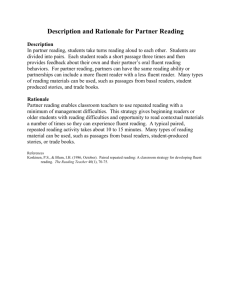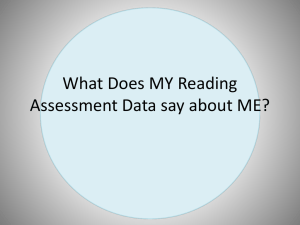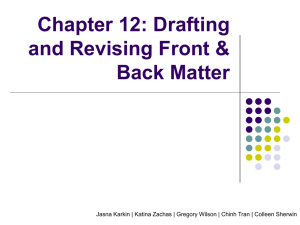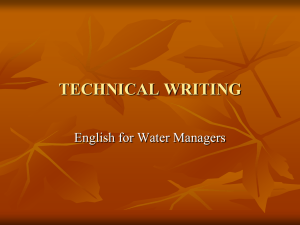Independent reading
advertisement
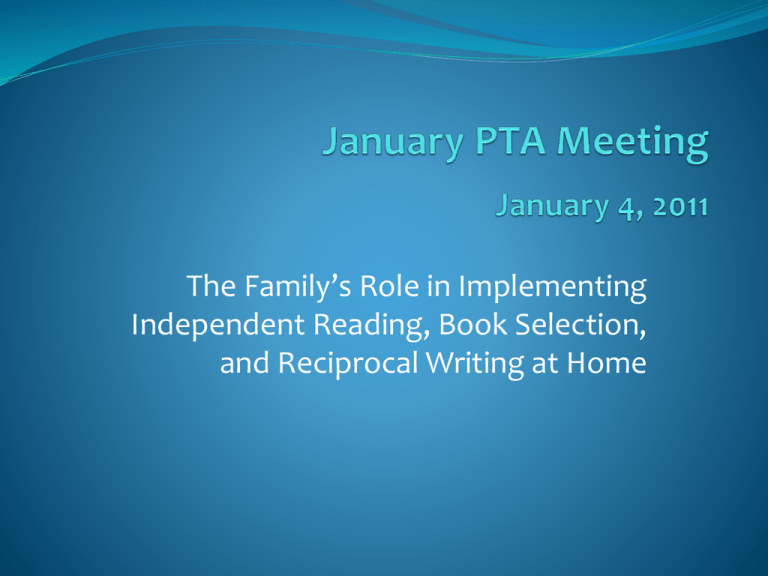
The Family’s Role in Implementing Independent Reading, Book Selection, and Reciprocal Writing at Home Outcomes By the end of this session, families will be able to: Summarize the research on the impact of independent reading on student achievement, and Identify key steps in establishing and monitoring an effective independent reading component. Discover ways to use reciprocal writing in the home Activator “If you’re trying to catch young readers, you have to fish with the right bait?” Katherine Paterson, National Ambassador for Young People’s Literature Impact of Number of Books in the Home “Children who have 500 or more books in the home get on average 3.2 years more schooling than children in bookless homes. Even just 20 books makes a difference. The availability of reading material has a strong impact on a child’s education…” Scholarly Culture and Educational success in 27 Nations Definition of Independent Reading Independent reading: “provides opportunities for students to initiate their own reading, the material should allow students to pursue their individual interests, provides opportunities to practice newly acquired skills, and to read more about topics and themes currently being studied in the classroom.” A Book is a Present, Mooney, page 74 What does it look like if you value it? What’s the benefit? Where’s the research? WHY? “…to accelerate the literacy development of lower-achieving children especially-must start by considering the issue of volume of reading.” Allington “…silent reading volume is the most obvious strategy for improving reading achievement.” Leinhardt/Allington Research 10 to 15 minutes of daily reading shows a 20 percentile point increase on standardized tests Dick Anderson But what does 45 minutes get you? Research 90th percentile child reads 5 times as much as the 50th percentile child (90th percentile child reads approximately 45 minutes/day) 50th percentile child reads 9 times as much as the 10th percentile child Dick Anderson Impact on Standardized Tests 50 Reading Minutes per Day 45 40 30 20 9 10 1 0 90th 50th Percentile Rank 10th Minutes per Day Variation in Amount of Independent Reading Minutes/Day Reading 67.3 33.4 16.9 9.2 4.3 1.0 Exposed to # Words/Year 4,733,000 2,357,000 1,168,000 601,000 251,000 51,100 Percentile Rank 98th 90th 70th 50th 30th 10th Reading Research Quarterly, Vol. 3, 1988, “Growth in reading and how children spend their time out of school.” Importance of Modeling “Children who read the most, read the best.” NAEP Levels of Text Difficulty Independent: Relatively easy text for the reader, with no more than 1 in 20 words difficult (95% success) Instructional: Challenging, but manageable text for the reader, with no more than 1 in 10 words difficult for the reader (90% success) Frustration: Difficult text for the reader, with more than 1 in 10 words difficult for the reader (<90% success) Stages of Reading Development Early Emergent Emergent Levels A-C Levels D-J Reading Early Fluent Fluent Levels K-P Levels Q-Z Lexile Measured by • Word frequency • Sentence length. Other • Content • Child age and interests • Design of the actual book. If we know how well a student can read and how hard a specific book is to comprehend, we can predict how well that student will likely understand the book. Lexile Shown as a number with an "L" after it — 880L is 880 Lexile. Only available for 3rd through 8th grade students (the MAP-R provides this measure) A student gets his or her Lexile reader measure from a reading test or program. Range from below 200L (beginning reader) to above 1700L (advanced readers). Grade Level End of First Quarter End of Second Quarter End of Third Quarter Kindergarten NA Level 1 (A) Level 2-3 (B-C) Levels 12-15 (H-I) Level L Level O Winter 197 First Grade Second Grade Third Grade Target RIT Levels 5-7 Levels 8-11 (E(D-E) G) Level J Level K Level M Level N Fall 192 End of Fourth Quarter Lexile Range Level 4 (C) Levels 16-17 200-400 (I) Level M 300-600 Level P 500-800 Spring 200 Fourth Grade Target RIT Levels Q-R Fall 201 Levels S-T Winter 204 600-900 Spring 207 Fifth Grade Target RIT Levels T-U Fall 208 Levels V-W Winter 210 700-1000 Spring 212 Helpful Hints for Age Appropriate Books Look on the back of the book Some books might say RL3 for reading level 3, or RL:5.9 for reading level 5.9. Less specific designations might say 007-009 for ages 7 to 9, or 0812 for ages 8 to 12. Publishers designations are confusing, and often change. Reading levels are generally only printed on the paperback versions of books. Selecting Books at the Library When trying to judge the reading difficulty of a book, keep these suggestions in mind: the ratio of pictures to word the difficulty of words the complexity of the story 5 Finger Rule Have your child begin reading a page of the book Put down one finger each time he or she struggles with a word. If they reach the end of the page before you get to five fingers, the book is written at a comfortable level for independent reading. What to do for Challenged Readers? Challenged readers may want to be engaged or may have struggled so long they’ve given up You can expect teachers to: Provide instruction on how to select a text they can read Coach students on book selection Lead students to choices that they will enjoy Find a series students like (similar main characters & text organization) Encourage students to stop periodically to restate the “big idea” Frequently monitor and provide feedback “We must not only teach children how to read well; we must also teach children how to love reading.” Lucy Calkins HOW? Choice Read Aloud Great books Model a love of reading Strategies for Repeated Oral Reading • Reading 1 to 1 with an adult • Reading along with a taped model • Reading aloud simultaneously in a group StudentAdult Choral Tape Assisted Partner • Reading aloud with a partner who is fluent or of equal ability Activities for Repeated Reading Student–adult reading—reading one-on-one with an adult, who provides a model of fluent reading, helps with word recognition, and offers feedback. Choral reading—reading aloud simultaneously in a group. Tape-assisted reading—reading aloud simultaneously or as an echo with an audio-taped model. Partner reading—reading aloud with a more fluent partner (or with a partner of equal ability) who provides a model of fluent reading, helps with word recognition, and provides feedback. Readers’ theatre—the rehearsing and performing before an audience of a dialogue-rich script derived from a book. Students are best motivated to read independently— and thus grow as readers—when they can find books in their individual areas of interest as well as in their lexile range James Sangil Kim (Kim, J. S., 2006. “Effects of a Voluntary Summer Reading Intervention on Reading Achievement: Results From a Randomized Field Trial.” . Levels of Reading Comprehension Literal • • • • • • • • • Interpretive • • Applied What is actually stated. Facts and details Rote learning and memorization Surface understanding only Common questions used to illicit this type of thinking are who, what, when, and where questions What is implied or meant, rather than what is actually stated. Drawing inferences & Tapping into prior knowledge / experience Attaching new learning to old information Making logical leaps and educated guesses Reading between the lines to determine what is meant by what is stated. Questions asked are open-ended, thought-provoking questions like why, what if, and how. • Taking what was said (literal) and then what was meant by what was said (interpretive) and then extend (apply) the concepts or ideas beyond the situation. • Analyzing • Synthesizing • Applying • In this level we are analyzing or synthesizing information and applying it to other information Reading Comprehension Activate prior knowledge, and connect the applicable prior experiences to the reading (if students don't have the requisite background knowledge about a topic, they will be unable to comprehend) Set Purposes Predict Decode Text — identify word and sentence meanings Summarize — bring meaning forward throughout the reading, building on prior information to create new and fuller meanings Visualize — see characters, settings, situations, ideas, mental models Question Monitor understanding - the most salient difference between good and poor readers is that good readers know when — and often why — they are not comprehending Use Clarifying and Corrective strategies where needed Reflect on and Apply the meaning that has been made to new situations Teaching Model DO — YOU WATCH I DO — YOU HELP YOU DO TOGETHER — I HELP YOU DO INDEPENDENTLY — I WATCH Another way of putting it is from the students‘ perspectives: SHOW ME — HELP ME — LET ME Resources on the Web Children’s Book Council This non-profit trade organization is dedicated to encouraging literacy and the use and enjoyment of children's books. Annual reading lists include Notable Social Studies Trade Books for Young People, Outstanding Science Trade Books for Students K-12, and Children’s Choices. The CBC also sponsors Young People's Poetry Week and Children's Book Week each year. http://www.cbcbooks.org/ Hoagie’s Gifted Provides details on a few of the most popular means for determining "reading level http://www.hoagiesgifted.org/reading_levels.htm Scholastic Book Wizard This site helps parents and teachers find children’s books for all ages, grades, and reading levels. Type the name of a book into the search field and find other Scholastic books at a similar level. http://bookwizard.scholastic.com/tbw/homePage.do What about Writing? Writing is a process of communicating meaning. Writing is the process of making thinking visible. Writing is a process of constructing meaning through language and expression. Writing must be fluent and automatic. Writing must be strategic. Writing requires motivation. Reasons Students Write Writing for Personal Expression involves using figurative language to express thoughts and feelings in personal narratives, poetry, plays, memoirs, friendly letters, fables, folk tales, and various other literary forms. Write to Inform they explain, describe, state, and organize facts about a topic, and give directions on how to perform a task. The forms they use may include articles, reports, biographies, reviews, science investigations, brochures, or speeches. Writing to Persuade is to convince the reader to consider the writer’s point of view. Persuasion may take the forms of editorials, advertisements, or requests. What we teach Techniques and information that are needed in developing the craft of writing 1. Practice and application of grammar, usage, mechanics, spelling, and handwriting 2. The writing process Organizational structure for thinking about, composing, and refining writing. Prewriting, drafting, conferencing, revising, editing, and publishing Types of Writing Shared (Modeled) Independent Interactive Writers Workshop BCR’s Brief Constructed Response: The ability to answer a targeted question after reading a short story or article. Rubric for Scoring 3 The response demonstrates an understanding of the complexities of the text. Addresses the demands of the question Effectively uses text-relevant information to clarify or extend understanding 2 The response demonstrates a general understanding of the text. Partially addresses the demands of the question Uses text-based and/or text-relevant information to show understanding. 1 The response demonstrates minimal understanding of the text Minimally addresses the demands of the question Uses minimal information to show understanding of the text in relation to the question 0 The response is completely incorrect or irrelevant to the question, or missing All responses are scored individually, double scored with teammates, and analyzed for instructional implications Ways to Encourage Kids at Home Provide Tools and Opportunities for Writing Mechanical pencils and gel pens are fun for kids Fun paper (colored, with lines, stationary, scrapbook style, note cards, or journal) Steps to Writing at Home First, encourage your child to talk about what he is going to write. 2. Ask them to write what they say or YOU write for them (dictation/scribe). 3. Encourage practice and make it fun to encourage a love of writing from an early age. 1. Writing Activities at Home Drawing Ask questions about the drawings. "That's a beautiful drawing. What is the girl doing?“ "Why is the boy crying?" "Can you tell me what is happening in the picture?" Use each drawing as a stimulus for writing with words of encouragement and praise. Find something positive to say about each drawing. If they are at the stage where they can write, have them write a sentence or two about each drawing. Journals (not a diary) Encourage your older children to keep journals, as this is an excellent outlet for them to express their inner feelings and emotions. If they are willing to share their entries with you, utilize the opportunity to read and discuss what is written. Writing Activities at Home Travel After a trip to a place of interest, have your children write a paragraph or two about their experiences. Having a discussion prior to writing will refresh their memories and is considered a brainstorming technique. Goal Setting Suggest that your children write goals and how they plan to accomplish them. Home Writing Grocery lists, directions, and instructions.
